Strategic Information Systems: Internal Audit of Giant Eggplant
VerifiedAdded on 2022/08/29
|11
|2590
|12
Case Study
AI Summary
This assignment presents an internal audit of Giant Eggplant, a business selling fruits and vegetables. The report begins with an introduction to business operations, emphasizing the importance of accounting and internal controls. It then details the revenue and expenditure cycles through data flow diagrams, outlining the processes involved in sales and purchases. The case study identifies internal control weaknesses, such as the lack of specific job roles, physical security, and data comparison between departments. The report concludes by recommending IT controls, including an in-house database management system and an information system for automated updates to improve efficiency and business expansion. The references include relevant sources.

Running head: INTERNAL AUDIT OF GIANT EGGPLANT
INTERNAL AUDIT OF GIANT EGGPLANT
Name of the student:
Number of the student:
Name of the university:
Author Note:
INTERNAL AUDIT OF GIANT EGGPLANT
Name of the student:
Number of the student:
Name of the university:
Author Note:
Paraphrase This Document
Need a fresh take? Get an instant paraphrase of this document with our AI Paraphraser
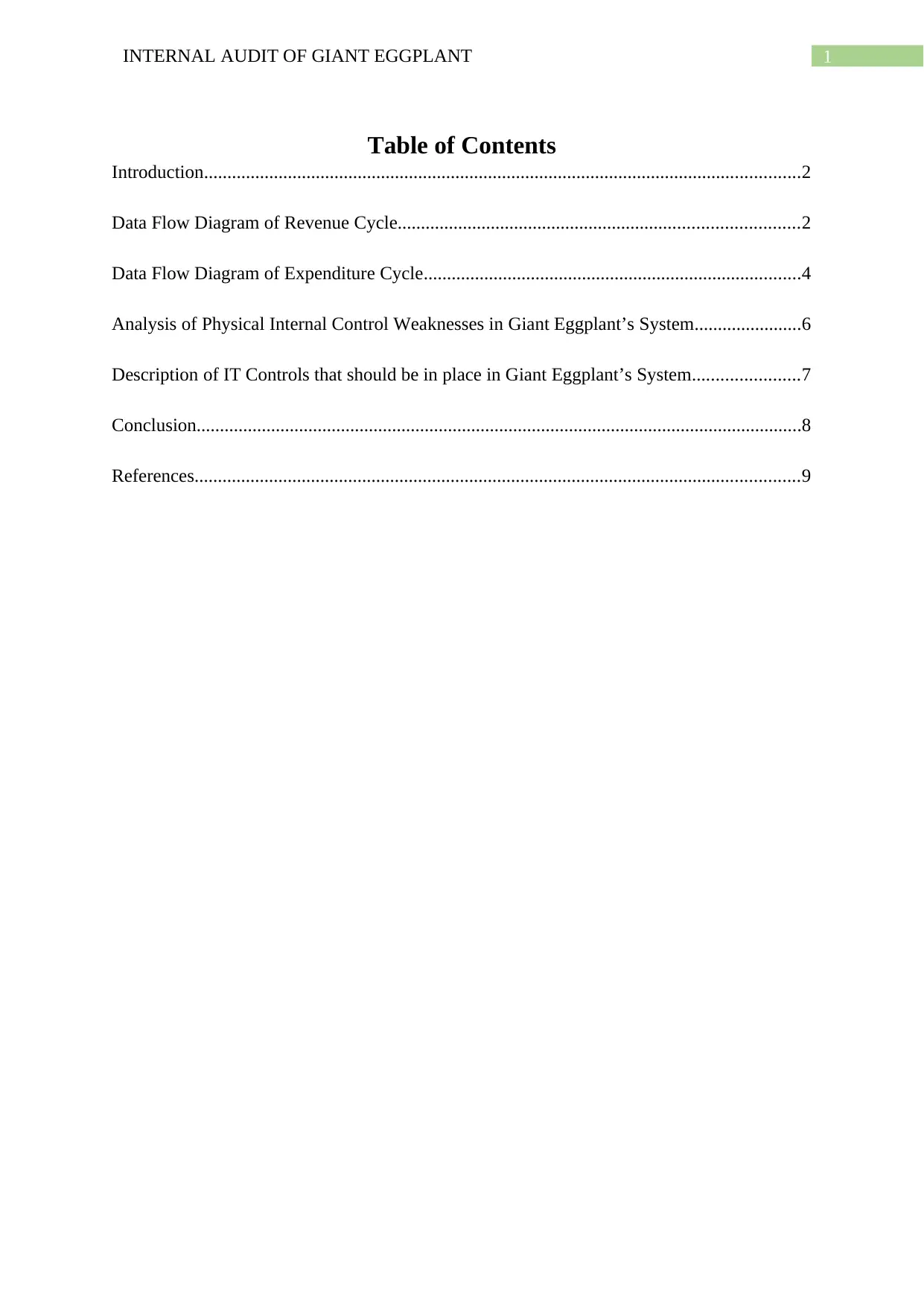
1INTERNAL AUDIT OF GIANT EGGPLANT
Table of Contents
Introduction................................................................................................................................2
Data Flow Diagram of Revenue Cycle......................................................................................2
Data Flow Diagram of Expenditure Cycle.................................................................................4
Analysis of Physical Internal Control Weaknesses in Giant Eggplant’s System.......................6
Description of IT Controls that should be in place in Giant Eggplant’s System.......................7
Conclusion..................................................................................................................................8
References..................................................................................................................................9
Table of Contents
Introduction................................................................................................................................2
Data Flow Diagram of Revenue Cycle......................................................................................2
Data Flow Diagram of Expenditure Cycle.................................................................................4
Analysis of Physical Internal Control Weaknesses in Giant Eggplant’s System.......................6
Description of IT Controls that should be in place in Giant Eggplant’s System.......................7
Conclusion..................................................................................................................................8
References..................................................................................................................................9
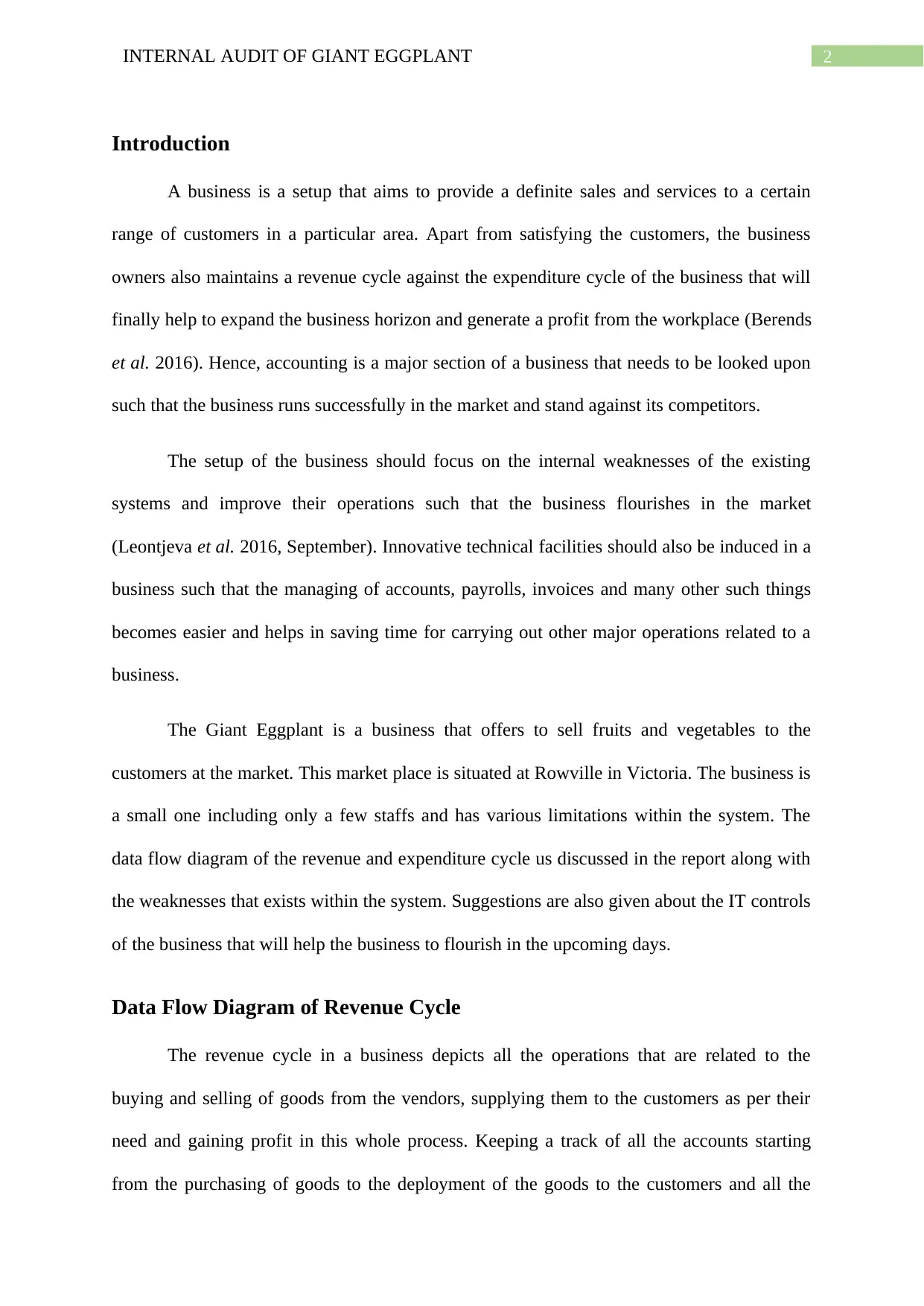
2INTERNAL AUDIT OF GIANT EGGPLANT
Introduction
A business is a setup that aims to provide a definite sales and services to a certain
range of customers in a particular area. Apart from satisfying the customers, the business
owners also maintains a revenue cycle against the expenditure cycle of the business that will
finally help to expand the business horizon and generate a profit from the workplace (Berends
et al. 2016). Hence, accounting is a major section of a business that needs to be looked upon
such that the business runs successfully in the market and stand against its competitors.
The setup of the business should focus on the internal weaknesses of the existing
systems and improve their operations such that the business flourishes in the market
(Leontjeva et al. 2016, September). Innovative technical facilities should also be induced in a
business such that the managing of accounts, payrolls, invoices and many other such things
becomes easier and helps in saving time for carrying out other major operations related to a
business.
The Giant Eggplant is a business that offers to sell fruits and vegetables to the
customers at the market. This market place is situated at Rowville in Victoria. The business is
a small one including only a few staffs and has various limitations within the system. The
data flow diagram of the revenue and expenditure cycle us discussed in the report along with
the weaknesses that exists within the system. Suggestions are also given about the IT controls
of the business that will help the business to flourish in the upcoming days.
Data Flow Diagram of Revenue Cycle
The revenue cycle in a business depicts all the operations that are related to the
buying and selling of goods from the vendors, supplying them to the customers as per their
need and gaining profit in this whole process. Keeping a track of all the accounts starting
from the purchasing of goods to the deployment of the goods to the customers and all the
Introduction
A business is a setup that aims to provide a definite sales and services to a certain
range of customers in a particular area. Apart from satisfying the customers, the business
owners also maintains a revenue cycle against the expenditure cycle of the business that will
finally help to expand the business horizon and generate a profit from the workplace (Berends
et al. 2016). Hence, accounting is a major section of a business that needs to be looked upon
such that the business runs successfully in the market and stand against its competitors.
The setup of the business should focus on the internal weaknesses of the existing
systems and improve their operations such that the business flourishes in the market
(Leontjeva et al. 2016, September). Innovative technical facilities should also be induced in a
business such that the managing of accounts, payrolls, invoices and many other such things
becomes easier and helps in saving time for carrying out other major operations related to a
business.
The Giant Eggplant is a business that offers to sell fruits and vegetables to the
customers at the market. This market place is situated at Rowville in Victoria. The business is
a small one including only a few staffs and has various limitations within the system. The
data flow diagram of the revenue and expenditure cycle us discussed in the report along with
the weaknesses that exists within the system. Suggestions are also given about the IT controls
of the business that will help the business to flourish in the upcoming days.
Data Flow Diagram of Revenue Cycle
The revenue cycle in a business depicts all the operations that are related to the
buying and selling of goods from the vendors, supplying them to the customers as per their
need and gaining profit in this whole process. Keeping a track of all the accounts starting
from the purchasing of goods to the deployment of the goods to the customers and all the
⊘ This is a preview!⊘
Do you want full access?
Subscribe today to unlock all pages.

Trusted by 1+ million students worldwide
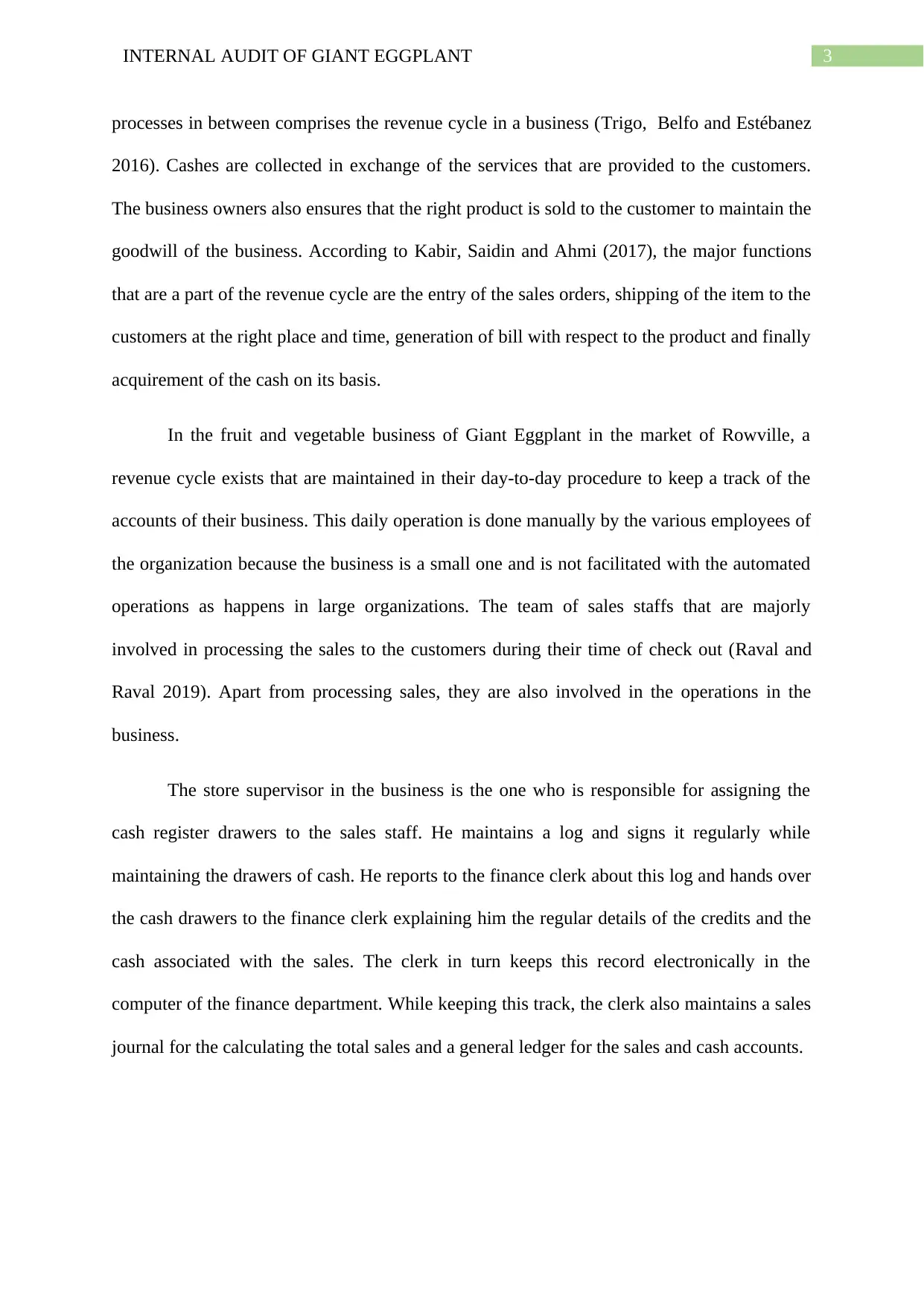
3INTERNAL AUDIT OF GIANT EGGPLANT
processes in between comprises the revenue cycle in a business (Trigo, Belfo and Estébanez
2016). Cashes are collected in exchange of the services that are provided to the customers.
The business owners also ensures that the right product is sold to the customer to maintain the
goodwill of the business. According to Kabir, Saidin and Ahmi (2017), the major functions
that are a part of the revenue cycle are the entry of the sales orders, shipping of the item to the
customers at the right place and time, generation of bill with respect to the product and finally
acquirement of the cash on its basis.
In the fruit and vegetable business of Giant Eggplant in the market of Rowville, a
revenue cycle exists that are maintained in their day-to-day procedure to keep a track of the
accounts of their business. This daily operation is done manually by the various employees of
the organization because the business is a small one and is not facilitated with the automated
operations as happens in large organizations. The team of sales staffs that are majorly
involved in processing the sales to the customers during their time of check out (Raval and
Raval 2019). Apart from processing sales, they are also involved in the operations in the
business.
The store supervisor in the business is the one who is responsible for assigning the
cash register drawers to the sales staff. He maintains a log and signs it regularly while
maintaining the drawers of cash. He reports to the finance clerk about this log and hands over
the cash drawers to the finance clerk explaining him the regular details of the credits and the
cash associated with the sales. The clerk in turn keeps this record electronically in the
computer of the finance department. While keeping this track, the clerk also maintains a sales
journal for the calculating the total sales and a general ledger for the sales and cash accounts.
processes in between comprises the revenue cycle in a business (Trigo, Belfo and Estébanez
2016). Cashes are collected in exchange of the services that are provided to the customers.
The business owners also ensures that the right product is sold to the customer to maintain the
goodwill of the business. According to Kabir, Saidin and Ahmi (2017), the major functions
that are a part of the revenue cycle are the entry of the sales orders, shipping of the item to the
customers at the right place and time, generation of bill with respect to the product and finally
acquirement of the cash on its basis.
In the fruit and vegetable business of Giant Eggplant in the market of Rowville, a
revenue cycle exists that are maintained in their day-to-day procedure to keep a track of the
accounts of their business. This daily operation is done manually by the various employees of
the organization because the business is a small one and is not facilitated with the automated
operations as happens in large organizations. The team of sales staffs that are majorly
involved in processing the sales to the customers during their time of check out (Raval and
Raval 2019). Apart from processing sales, they are also involved in the operations in the
business.
The store supervisor in the business is the one who is responsible for assigning the
cash register drawers to the sales staff. He maintains a log and signs it regularly while
maintaining the drawers of cash. He reports to the finance clerk about this log and hands over
the cash drawers to the finance clerk explaining him the regular details of the credits and the
cash associated with the sales. The clerk in turn keeps this record electronically in the
computer of the finance department. While keeping this track, the clerk also maintains a sales
journal for the calculating the total sales and a general ledger for the sales and cash accounts.
Paraphrase This Document
Need a fresh take? Get an instant paraphrase of this document with our AI Paraphraser
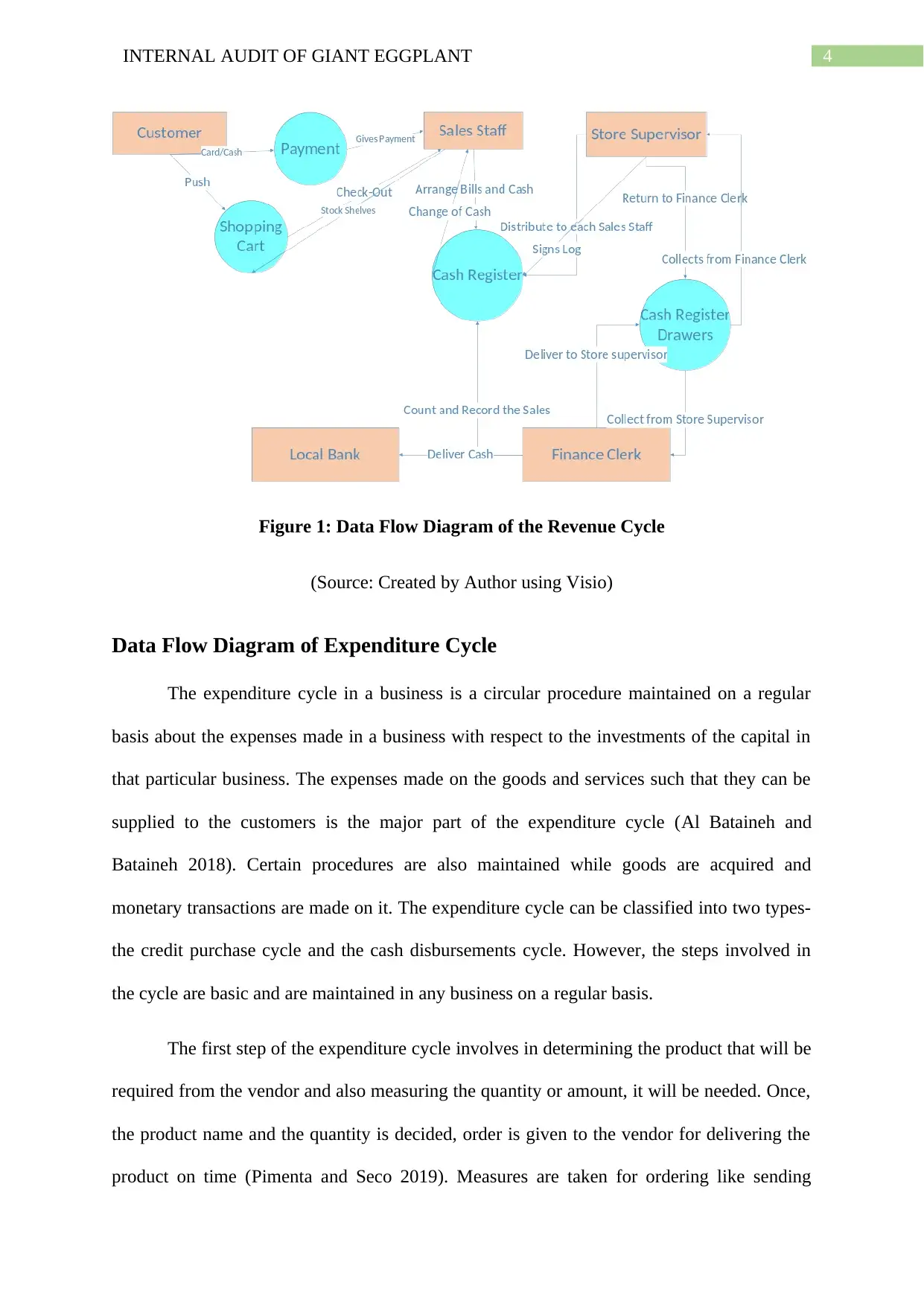
4INTERNAL AUDIT OF GIANT EGGPLANT
Figure 1: Data Flow Diagram of the Revenue Cycle
(Source: Created by Author using Visio)
Data Flow Diagram of Expenditure Cycle
The expenditure cycle in a business is a circular procedure maintained on a regular
basis about the expenses made in a business with respect to the investments of the capital in
that particular business. The expenses made on the goods and services such that they can be
supplied to the customers is the major part of the expenditure cycle (Al Bataineh and
Bataineh 2018). Certain procedures are also maintained while goods are acquired and
monetary transactions are made on it. The expenditure cycle can be classified into two types-
the credit purchase cycle and the cash disbursements cycle. However, the steps involved in
the cycle are basic and are maintained in any business on a regular basis.
The first step of the expenditure cycle involves in determining the product that will be
required from the vendor and also measuring the quantity or amount, it will be needed. Once,
the product name and the quantity is decided, order is given to the vendor for delivering the
product on time (Pimenta and Seco 2019). Measures are taken for ordering like sending
Figure 1: Data Flow Diagram of the Revenue Cycle
(Source: Created by Author using Visio)
Data Flow Diagram of Expenditure Cycle
The expenditure cycle in a business is a circular procedure maintained on a regular
basis about the expenses made in a business with respect to the investments of the capital in
that particular business. The expenses made on the goods and services such that they can be
supplied to the customers is the major part of the expenditure cycle (Al Bataineh and
Bataineh 2018). Certain procedures are also maintained while goods are acquired and
monetary transactions are made on it. The expenditure cycle can be classified into two types-
the credit purchase cycle and the cash disbursements cycle. However, the steps involved in
the cycle are basic and are maintained in any business on a regular basis.
The first step of the expenditure cycle involves in determining the product that will be
required from the vendor and also measuring the quantity or amount, it will be needed. Once,
the product name and the quantity is decided, order is given to the vendor for delivering the
product on time (Pimenta and Seco 2019). Measures are taken for ordering like sending
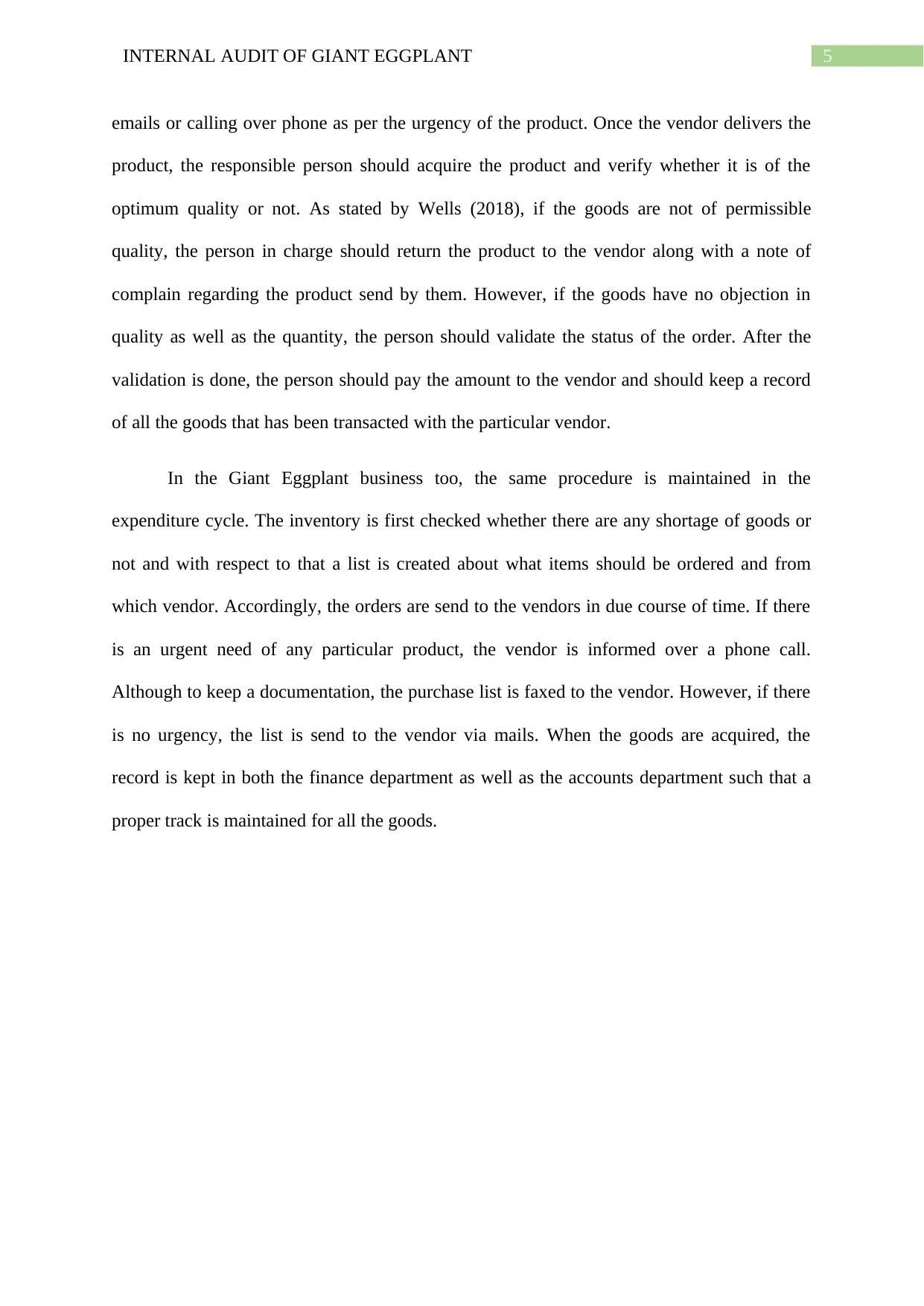
5INTERNAL AUDIT OF GIANT EGGPLANT
emails or calling over phone as per the urgency of the product. Once the vendor delivers the
product, the responsible person should acquire the product and verify whether it is of the
optimum quality or not. As stated by Wells (2018), if the goods are not of permissible
quality, the person in charge should return the product to the vendor along with a note of
complain regarding the product send by them. However, if the goods have no objection in
quality as well as the quantity, the person should validate the status of the order. After the
validation is done, the person should pay the amount to the vendor and should keep a record
of all the goods that has been transacted with the particular vendor.
In the Giant Eggplant business too, the same procedure is maintained in the
expenditure cycle. The inventory is first checked whether there are any shortage of goods or
not and with respect to that a list is created about what items should be ordered and from
which vendor. Accordingly, the orders are send to the vendors in due course of time. If there
is an urgent need of any particular product, the vendor is informed over a phone call.
Although to keep a documentation, the purchase list is faxed to the vendor. However, if there
is no urgency, the list is send to the vendor via mails. When the goods are acquired, the
record is kept in both the finance department as well as the accounts department such that a
proper track is maintained for all the goods.
emails or calling over phone as per the urgency of the product. Once the vendor delivers the
product, the responsible person should acquire the product and verify whether it is of the
optimum quality or not. As stated by Wells (2018), if the goods are not of permissible
quality, the person in charge should return the product to the vendor along with a note of
complain regarding the product send by them. However, if the goods have no objection in
quality as well as the quantity, the person should validate the status of the order. After the
validation is done, the person should pay the amount to the vendor and should keep a record
of all the goods that has been transacted with the particular vendor.
In the Giant Eggplant business too, the same procedure is maintained in the
expenditure cycle. The inventory is first checked whether there are any shortage of goods or
not and with respect to that a list is created about what items should be ordered and from
which vendor. Accordingly, the orders are send to the vendors in due course of time. If there
is an urgent need of any particular product, the vendor is informed over a phone call.
Although to keep a documentation, the purchase list is faxed to the vendor. However, if there
is no urgency, the list is send to the vendor via mails. When the goods are acquired, the
record is kept in both the finance department as well as the accounts department such that a
proper track is maintained for all the goods.
⊘ This is a preview!⊘
Do you want full access?
Subscribe today to unlock all pages.

Trusted by 1+ million students worldwide
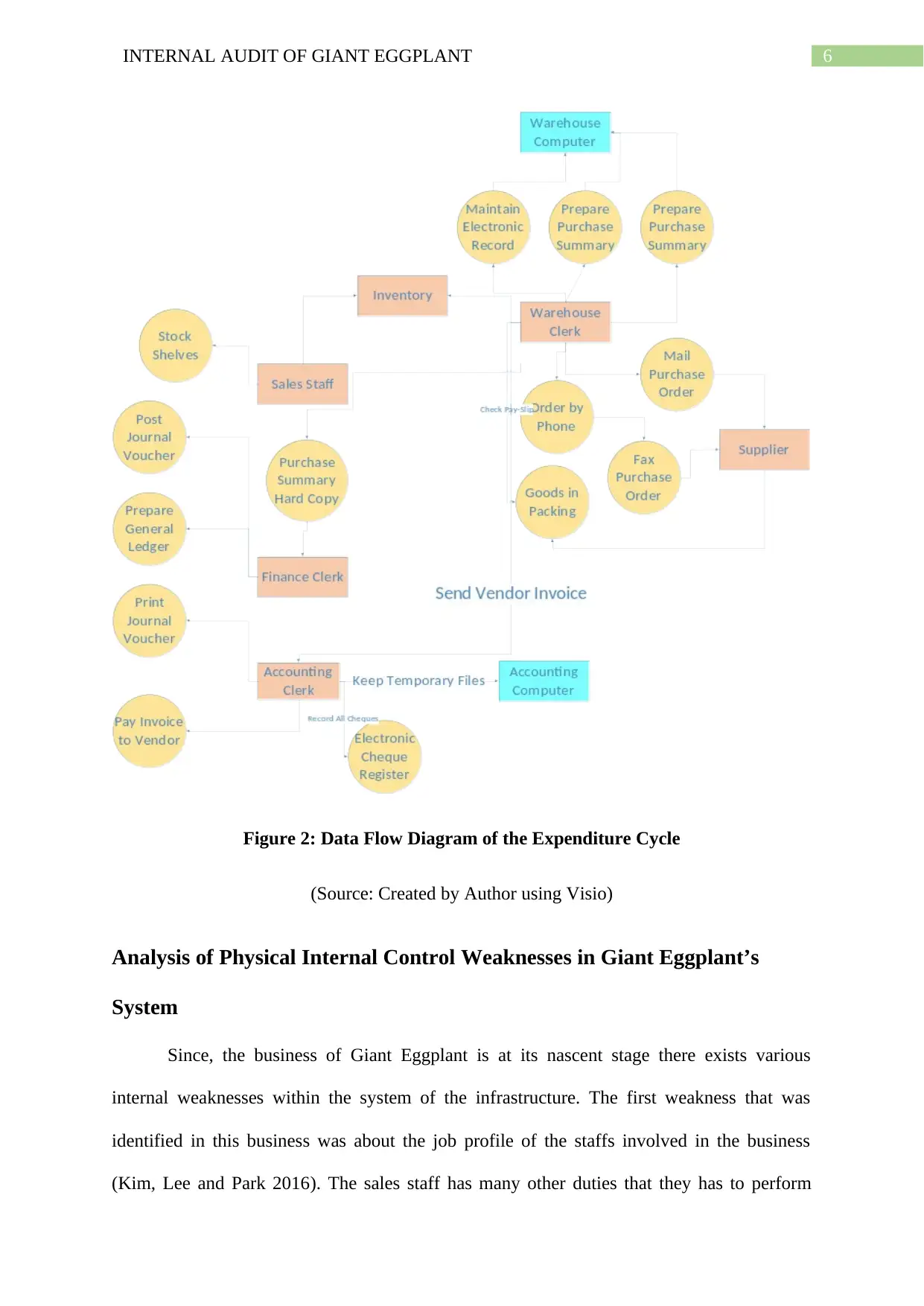
6INTERNAL AUDIT OF GIANT EGGPLANT
Figure 2: Data Flow Diagram of the Expenditure Cycle
(Source: Created by Author using Visio)
Analysis of Physical Internal Control Weaknesses in Giant Eggplant’s
System
Since, the business of Giant Eggplant is at its nascent stage there exists various
internal weaknesses within the system of the infrastructure. The first weakness that was
identified in this business was about the job profile of the staffs involved in the business
(Kim, Lee and Park 2016). The sales staff has many other duties that they has to perform
Figure 2: Data Flow Diagram of the Expenditure Cycle
(Source: Created by Author using Visio)
Analysis of Physical Internal Control Weaknesses in Giant Eggplant’s
System
Since, the business of Giant Eggplant is at its nascent stage there exists various
internal weaknesses within the system of the infrastructure. The first weakness that was
identified in this business was about the job profile of the staffs involved in the business
(Kim, Lee and Park 2016). The sales staff has many other duties that they has to perform
Paraphrase This Document
Need a fresh take? Get an instant paraphrase of this document with our AI Paraphraser
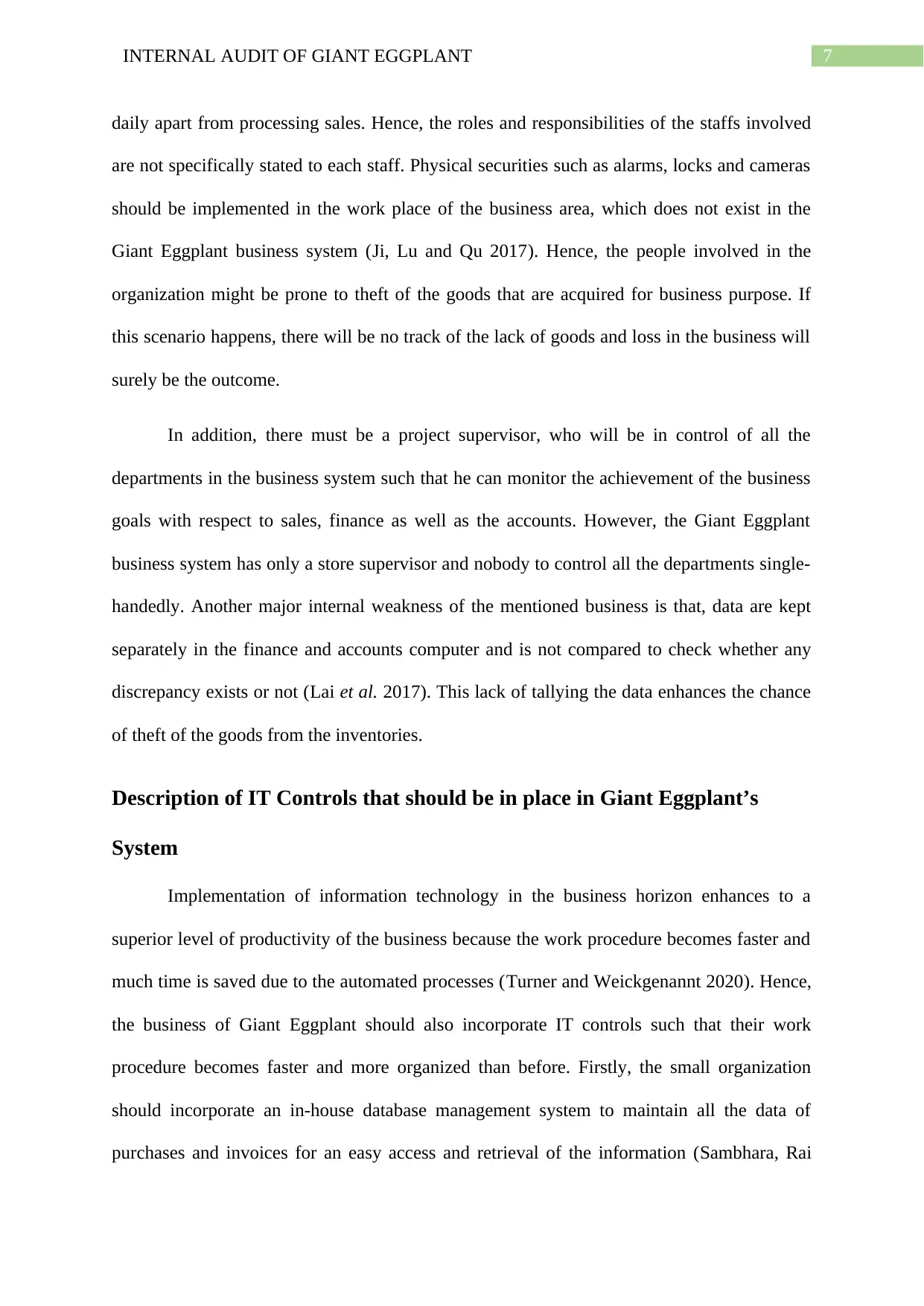
7INTERNAL AUDIT OF GIANT EGGPLANT
daily apart from processing sales. Hence, the roles and responsibilities of the staffs involved
are not specifically stated to each staff. Physical securities such as alarms, locks and cameras
should be implemented in the work place of the business area, which does not exist in the
Giant Eggplant business system (Ji, Lu and Qu 2017). Hence, the people involved in the
organization might be prone to theft of the goods that are acquired for business purpose. If
this scenario happens, there will be no track of the lack of goods and loss in the business will
surely be the outcome.
In addition, there must be a project supervisor, who will be in control of all the
departments in the business system such that he can monitor the achievement of the business
goals with respect to sales, finance as well as the accounts. However, the Giant Eggplant
business system has only a store supervisor and nobody to control all the departments single-
handedly. Another major internal weakness of the mentioned business is that, data are kept
separately in the finance and accounts computer and is not compared to check whether any
discrepancy exists or not (Lai et al. 2017). This lack of tallying the data enhances the chance
of theft of the goods from the inventories.
Description of IT Controls that should be in place in Giant Eggplant’s
System
Implementation of information technology in the business horizon enhances to a
superior level of productivity of the business because the work procedure becomes faster and
much time is saved due to the automated processes (Turner and Weickgenannt 2020). Hence,
the business of Giant Eggplant should also incorporate IT controls such that their work
procedure becomes faster and more organized than before. Firstly, the small organization
should incorporate an in-house database management system to maintain all the data of
purchases and invoices for an easy access and retrieval of the information (Sambhara, Rai
daily apart from processing sales. Hence, the roles and responsibilities of the staffs involved
are not specifically stated to each staff. Physical securities such as alarms, locks and cameras
should be implemented in the work place of the business area, which does not exist in the
Giant Eggplant business system (Ji, Lu and Qu 2017). Hence, the people involved in the
organization might be prone to theft of the goods that are acquired for business purpose. If
this scenario happens, there will be no track of the lack of goods and loss in the business will
surely be the outcome.
In addition, there must be a project supervisor, who will be in control of all the
departments in the business system such that he can monitor the achievement of the business
goals with respect to sales, finance as well as the accounts. However, the Giant Eggplant
business system has only a store supervisor and nobody to control all the departments single-
handedly. Another major internal weakness of the mentioned business is that, data are kept
separately in the finance and accounts computer and is not compared to check whether any
discrepancy exists or not (Lai et al. 2017). This lack of tallying the data enhances the chance
of theft of the goods from the inventories.
Description of IT Controls that should be in place in Giant Eggplant’s
System
Implementation of information technology in the business horizon enhances to a
superior level of productivity of the business because the work procedure becomes faster and
much time is saved due to the automated processes (Turner and Weickgenannt 2020). Hence,
the business of Giant Eggplant should also incorporate IT controls such that their work
procedure becomes faster and more organized than before. Firstly, the small organization
should incorporate an in-house database management system to maintain all the data of
purchases and invoices for an easy access and retrieval of the information (Sambhara, Rai
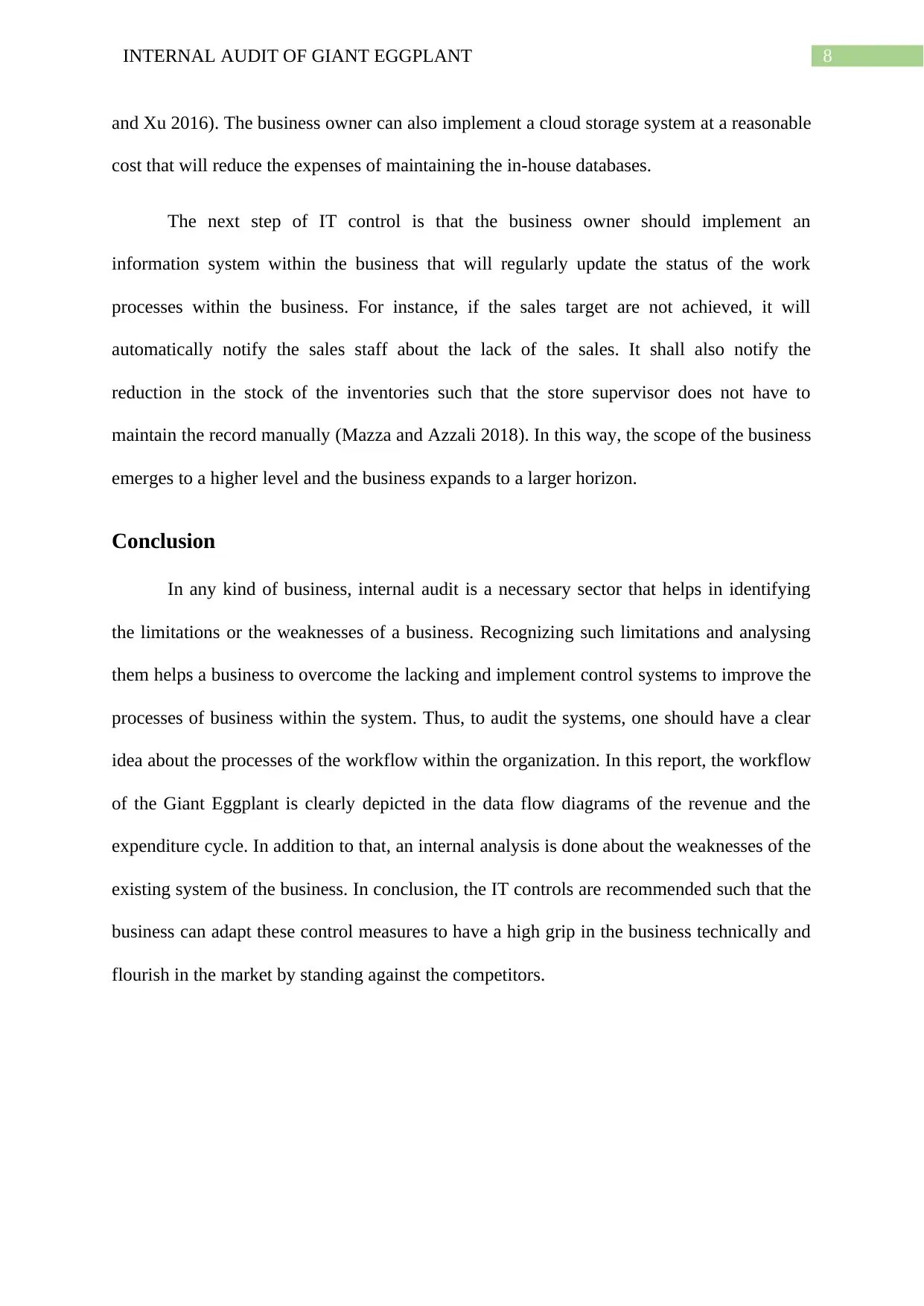
8INTERNAL AUDIT OF GIANT EGGPLANT
and Xu 2016). The business owner can also implement a cloud storage system at a reasonable
cost that will reduce the expenses of maintaining the in-house databases.
The next step of IT control is that the business owner should implement an
information system within the business that will regularly update the status of the work
processes within the business. For instance, if the sales target are not achieved, it will
automatically notify the sales staff about the lack of the sales. It shall also notify the
reduction in the stock of the inventories such that the store supervisor does not have to
maintain the record manually (Mazza and Azzali 2018). In this way, the scope of the business
emerges to a higher level and the business expands to a larger horizon.
Conclusion
In any kind of business, internal audit is a necessary sector that helps in identifying
the limitations or the weaknesses of a business. Recognizing such limitations and analysing
them helps a business to overcome the lacking and implement control systems to improve the
processes of business within the system. Thus, to audit the systems, one should have a clear
idea about the processes of the workflow within the organization. In this report, the workflow
of the Giant Eggplant is clearly depicted in the data flow diagrams of the revenue and the
expenditure cycle. In addition to that, an internal analysis is done about the weaknesses of the
existing system of the business. In conclusion, the IT controls are recommended such that the
business can adapt these control measures to have a high grip in the business technically and
flourish in the market by standing against the competitors.
and Xu 2016). The business owner can also implement a cloud storage system at a reasonable
cost that will reduce the expenses of maintaining the in-house databases.
The next step of IT control is that the business owner should implement an
information system within the business that will regularly update the status of the work
processes within the business. For instance, if the sales target are not achieved, it will
automatically notify the sales staff about the lack of the sales. It shall also notify the
reduction in the stock of the inventories such that the store supervisor does not have to
maintain the record manually (Mazza and Azzali 2018). In this way, the scope of the business
emerges to a higher level and the business expands to a larger horizon.
Conclusion
In any kind of business, internal audit is a necessary sector that helps in identifying
the limitations or the weaknesses of a business. Recognizing such limitations and analysing
them helps a business to overcome the lacking and implement control systems to improve the
processes of business within the system. Thus, to audit the systems, one should have a clear
idea about the processes of the workflow within the organization. In this report, the workflow
of the Giant Eggplant is clearly depicted in the data flow diagrams of the revenue and the
expenditure cycle. In addition to that, an internal analysis is done about the weaknesses of the
existing system of the business. In conclusion, the IT controls are recommended such that the
business can adapt these control measures to have a high grip in the business technically and
flourish in the market by standing against the competitors.
⊘ This is a preview!⊘
Do you want full access?
Subscribe today to unlock all pages.

Trusted by 1+ million students worldwide
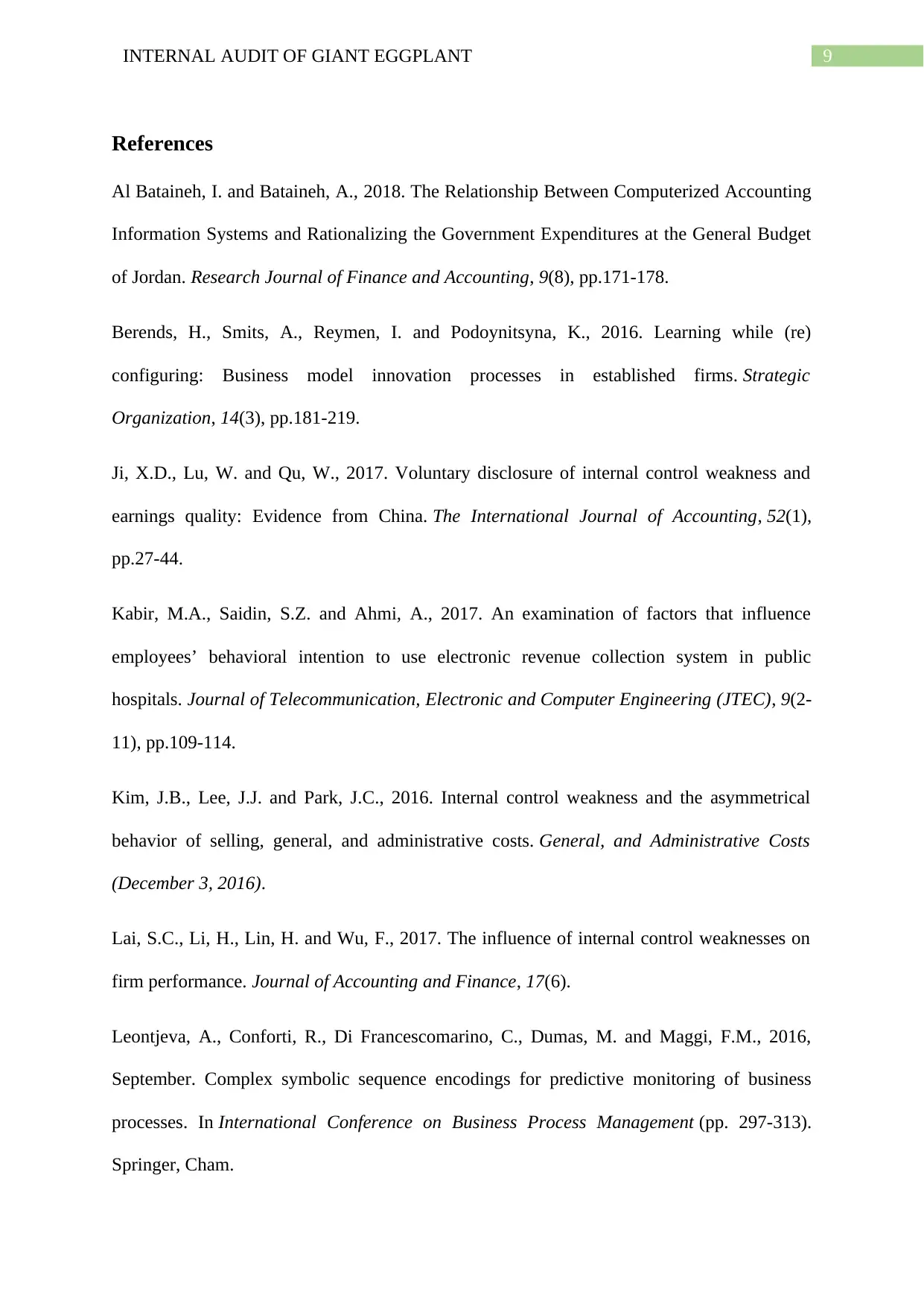
9INTERNAL AUDIT OF GIANT EGGPLANT
References
Al Bataineh, I. and Bataineh, A., 2018. The Relationship Between Computerized Accounting
Information Systems and Rationalizing the Government Expenditures at the General Budget
of Jordan. Research Journal of Finance and Accounting, 9(8), pp.171-178.
Berends, H., Smits, A., Reymen, I. and Podoynitsyna, K., 2016. Learning while (re)
configuring: Business model innovation processes in established firms. Strategic
Organization, 14(3), pp.181-219.
Ji, X.D., Lu, W. and Qu, W., 2017. Voluntary disclosure of internal control weakness and
earnings quality: Evidence from China. The International Journal of Accounting, 52(1),
pp.27-44.
Kabir, M.A., Saidin, S.Z. and Ahmi, A., 2017. An examination of factors that influence
employees’ behavioral intention to use electronic revenue collection system in public
hospitals. Journal of Telecommunication, Electronic and Computer Engineering (JTEC), 9(2-
11), pp.109-114.
Kim, J.B., Lee, J.J. and Park, J.C., 2016. Internal control weakness and the asymmetrical
behavior of selling, general, and administrative costs. General, and Administrative Costs
(December 3, 2016).
Lai, S.C., Li, H., Lin, H. and Wu, F., 2017. The influence of internal control weaknesses on
firm performance. Journal of Accounting and Finance, 17(6).
Leontjeva, A., Conforti, R., Di Francescomarino, C., Dumas, M. and Maggi, F.M., 2016,
September. Complex symbolic sequence encodings for predictive monitoring of business
processes. In International Conference on Business Process Management (pp. 297-313).
Springer, Cham.
References
Al Bataineh, I. and Bataineh, A., 2018. The Relationship Between Computerized Accounting
Information Systems and Rationalizing the Government Expenditures at the General Budget
of Jordan. Research Journal of Finance and Accounting, 9(8), pp.171-178.
Berends, H., Smits, A., Reymen, I. and Podoynitsyna, K., 2016. Learning while (re)
configuring: Business model innovation processes in established firms. Strategic
Organization, 14(3), pp.181-219.
Ji, X.D., Lu, W. and Qu, W., 2017. Voluntary disclosure of internal control weakness and
earnings quality: Evidence from China. The International Journal of Accounting, 52(1),
pp.27-44.
Kabir, M.A., Saidin, S.Z. and Ahmi, A., 2017. An examination of factors that influence
employees’ behavioral intention to use electronic revenue collection system in public
hospitals. Journal of Telecommunication, Electronic and Computer Engineering (JTEC), 9(2-
11), pp.109-114.
Kim, J.B., Lee, J.J. and Park, J.C., 2016. Internal control weakness and the asymmetrical
behavior of selling, general, and administrative costs. General, and Administrative Costs
(December 3, 2016).
Lai, S.C., Li, H., Lin, H. and Wu, F., 2017. The influence of internal control weaknesses on
firm performance. Journal of Accounting and Finance, 17(6).
Leontjeva, A., Conforti, R., Di Francescomarino, C., Dumas, M. and Maggi, F.M., 2016,
September. Complex symbolic sequence encodings for predictive monitoring of business
processes. In International Conference on Business Process Management (pp. 297-313).
Springer, Cham.
Paraphrase This Document
Need a fresh take? Get an instant paraphrase of this document with our AI Paraphraser
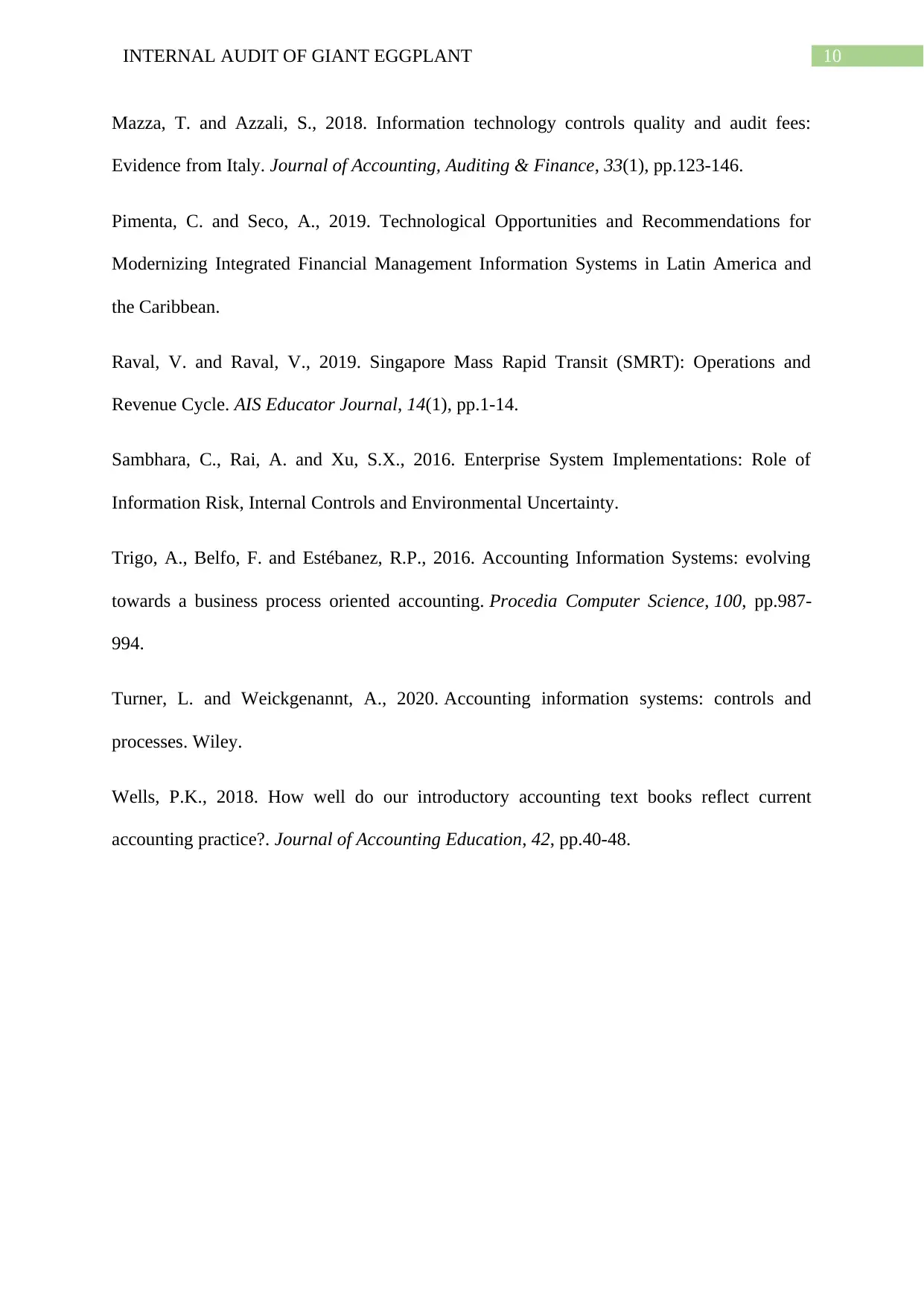
10INTERNAL AUDIT OF GIANT EGGPLANT
Mazza, T. and Azzali, S., 2018. Information technology controls quality and audit fees:
Evidence from Italy. Journal of Accounting, Auditing & Finance, 33(1), pp.123-146.
Pimenta, C. and Seco, A., 2019. Technological Opportunities and Recommendations for
Modernizing Integrated Financial Management Information Systems in Latin America and
the Caribbean.
Raval, V. and Raval, V., 2019. Singapore Mass Rapid Transit (SMRT): Operations and
Revenue Cycle. AIS Educator Journal, 14(1), pp.1-14.
Sambhara, C., Rai, A. and Xu, S.X., 2016. Enterprise System Implementations: Role of
Information Risk, Internal Controls and Environmental Uncertainty.
Trigo, A., Belfo, F. and Estébanez, R.P., 2016. Accounting Information Systems: evolving
towards a business process oriented accounting. Procedia Computer Science, 100, pp.987-
994.
Turner, L. and Weickgenannt, A., 2020. Accounting information systems: controls and
processes. Wiley.
Wells, P.K., 2018. How well do our introductory accounting text books reflect current
accounting practice?. Journal of Accounting Education, 42, pp.40-48.
Mazza, T. and Azzali, S., 2018. Information technology controls quality and audit fees:
Evidence from Italy. Journal of Accounting, Auditing & Finance, 33(1), pp.123-146.
Pimenta, C. and Seco, A., 2019. Technological Opportunities and Recommendations for
Modernizing Integrated Financial Management Information Systems in Latin America and
the Caribbean.
Raval, V. and Raval, V., 2019. Singapore Mass Rapid Transit (SMRT): Operations and
Revenue Cycle. AIS Educator Journal, 14(1), pp.1-14.
Sambhara, C., Rai, A. and Xu, S.X., 2016. Enterprise System Implementations: Role of
Information Risk, Internal Controls and Environmental Uncertainty.
Trigo, A., Belfo, F. and Estébanez, R.P., 2016. Accounting Information Systems: evolving
towards a business process oriented accounting. Procedia Computer Science, 100, pp.987-
994.
Turner, L. and Weickgenannt, A., 2020. Accounting information systems: controls and
processes. Wiley.
Wells, P.K., 2018. How well do our introductory accounting text books reflect current
accounting practice?. Journal of Accounting Education, 42, pp.40-48.
1 out of 11
Related Documents
Your All-in-One AI-Powered Toolkit for Academic Success.
+13062052269
info@desklib.com
Available 24*7 on WhatsApp / Email
![[object Object]](/_next/static/media/star-bottom.7253800d.svg)
Unlock your academic potential
© 2024 | Zucol Services PVT LTD | All rights reserved.





